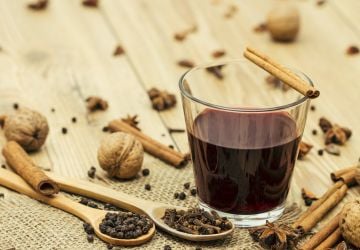NORWEGIAN CULTURE
 Ingredients
Ingredients
To serve 20-25
2 quarts dry red wine (about 2 standard 750 mL bottles)
2 quarts muscatel (or muscato)
1 pint sweet vermouth
2 tablespoons Angostura bitters
2 cups raisins
Peelings of 1 orange
12 whole cardamoms, bruised in a mortar with a pestle or by covering with
a towel and crushing with a rolling pin
10 whole cloves
1 piece (about 2 inches) of fresh ginger
1 stick cinnamon
1 ½ cups akevitt (preferably Linie)
1 ½ cups sugar
2 cups whole almonds, blanched and peeled
Recipe
Step 1
In a 6- to 8-quart enameled or stainless steel pot, mix together the dry red wine, muscatel, sweet vermouth, bitters, raisins, orange peel and the slightly crushed cardamoms, whole cloves, ginger and cinnamon. Cover and let the mixture stand at least 12 hours so that the flavors will develop and mingle.
Step 2
Shortly before serving, add the akevitt and the sugar. Stir well and bring it to a full boil over high heat.
Step 3
Remove at once from the heat, stir in the almonds and serve the hot gløgg in mugs. In Sweden, a small spoon is placed in each mug to scoop up the almonds and raisins.
Alternate Version
To make a simpler gløgg, divide the quantities of spices in half and mix them with 2 bottles of dry red wine. Leave it overnight, then stir in ¾ cup of sugar and bring it almost to a boil. Remove from the heat, stir in 1 cup of whole, blanched and peeled almonds, and serve hot.
Those are the original ingredients and instructions. Before making gløgg, read our commentary below.
Commentary from 2008
Forty years after this recipe was published, it holds up pretty well. Still, times have changed and moreover through experimentation we have made a number of adjustments and changes of our own.
First off, until this year, we had never made this gløgg the night before it was meant to be served. Frankly, we had never remembered. Every year we would take out the cookbook the day of the big Christmas party and realize we’d blown it yet again. However, we were never disappointed either. Having said that, this year, we did manage to throw the spices in the wine the night before and the result was even more delicious. So, if you’re organized enough to get it together a whole day ahead of time, by all means do so, but if you’re not, don’t let it stop you.
Secondly, muscatel per se can be difficult to find. Strictly speaking, muscatel is a sweet white dessert wine that is derived only from Muscat of Alexandria grapes. We have never been able to find muscatel in our area (Minneapolis/St. Paul) although we were able to find it online, with prices ranging from about $6 to almost $70. However, Muscato – derived from the same family of grapes – is widely (and cheaply) available and works great. If you really want to go for higher quality but can’t find a nice muscatel, I’m sure Lillet Blanc would be just fine. We have always used Linie Aquavit which compliments the spices nicely, but the Oslo brand would probably be good as well.
Another point is that we do not recommend simply chucking all the spices into the pot loose. In our experience people do not like finding whole cloves in their cups (or their teeth). Instead, we put the orange peel, the ginger and all of the spices – with the exception of the cinnamon stick – in a piece of cheesecloth, tie that off with a piece of string and toss the whole thing in with the wine at the very beginning, then take it out at the last second before serving. The cinnamon stick (or sticks – you can never have too much fresh cinnamon in there) we leave out to get a better flavor and also for fear they will puncture the cheesecloth. A side note: don’t try to substitute ground spices for the whole ones. We tried this the first time we made it, in order to save a few bucks, and the result was a gritty, chewy gløgg that had the body of coffee dregs. Shell out the extra $2 and buy the whole spices, or you’ll be sorry.
Finally – and most importantly – we never allow the gløgg to boil. We don’t know what “the Professor” was supposed to be a professor of, but it sure wasn’t chemistry. Alcohol boils at a lower temperature than water so bringing the gløgg to a boil even for a short time can severely deplete its psychoactive properties. We use a liquid thermometer and are careful to keep the mixture below 78°C (173°F), the point at which alcohol boils.
In a nutshell, our preparation is to simply start by mixing the red wine, the muscato, and the spices in the pot over low heat. Once this mixture has warmed up a little, add the akevitt and the vermouth to taste – generally, we use a little less vermouth and a little more akevitt than the recipe calls for. As the drink heats up, we gradually add the sugar, stirring regularly so that the sugar dissolves completely. Once that’s done, add the raisins and almonds. Then add the bitters, one tablespoon at a time, tasting after stirring in the first one. If it doesn’t need the second tablespoon of bitters, don’t add it.
The whole process will take a couple of hours. Don’t try to multitask when you’re making gløgg. You’re going to need every ounce of your steadily diminishing concentration to keep the stuff from boiling. It should be served warm, in small cups, and make sure everyone gets some raisins and almonds in their cup. Some people will complain about this, but after a cup or two, they’ll realize it’s the best gløgg they’ve ever had.
Skål!

 Ingredients
Ingredients